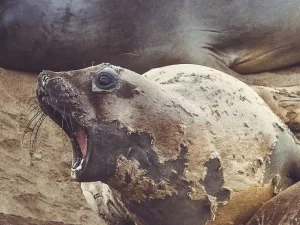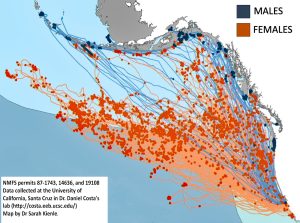Cover photo courtesy of Max Fowles, Friends of the Elephant Seal
This is the time of year when northern elephant seals get ready to head back out to the ocean, signaling the end of their season on the central coast. With content courtesy of California State Parks, Friends of the Elephant Seal, the National Park Service, and the Marine Mammal Center, we’ve compiled a blog post to answer some frequently asked questions about the elephant seals, their lives, and their interactions with people.

Why Do Elephant Seals Come To Our Shores?
Northern elephant seals come to rookeries along the California and Baja California coasts during the winter to give birth, nurse their babies, rest, and breed. Females focus on caring for their babies, who they will nurse for about a month as the baby grows from its birth weight of 70 pounds to its weaned weight of 300 pounds. Males spend their energy on maintaining control of their section of beach and their “harem” of females.

Are Northern Elephant Seals Endangered?
Northern elephant seals were hunted to near-extinction in the 19th century for their oil-rich blubber. In 1892 there were less than a hundred Northern elephant seals, and by 1900 they were believed to be extinct. Fortunately, there was one remaining population off the coast of Baja California, and this small group repopulated the species to its current size of about 100,000 individuals. They are no longer endangered, but they are protected by state law and the federal Marine Mammal Protection Act.

What Should I Do If I Encounter An Elephant Seal On The Beach?
While most seals will stay at the rookeries, you may occasionally see individuals on other beaches in the area. The Marine Mammal Center recommends remaining at least 50 feet away from the seal (that’s at least four seal lengths away), but more space is always better.

If you are with a dog, it’s important to keep the dog away from the seal. Both dogs and seals can carry diseases that can transfer to each other if they get too close or even through the sand.

If you are concerned that a seal is sick or injured, you can call the Marine Mammal Center hotline at 415-289-7325 (SEAL), or NOAA’s hotline at 866-767-6114. Note the exact location of the animal, as well as its condition and any tags or other markings.
Where Do Elephant Seals Go When They Leave Our Shores?
In February, females will return to the sea to feed after fasting for five weeks, leaving their weaned pups behind on the beach. In March, the adult males follow suit. During this time, the pups stay close to the beach as they learn to swim and feed. Throughout the spring and summer, adults and juveniles of both sexes will return to the beaches to molt.

After molting, the seals will return to the ocean to feed. Just as the biggest males are leaving the beach in September, the juveniles will return for the fall and winter season at the rookery. Then the season begins again with the return of the adult males in November.

How Can I Learn More About Elephant Seals And Get Involved?
Organizations like Friends of the Elephant Seal and the Marine Mammal Center are always looking for volunteers, members, and donations to support their important work. Take the pledge to become a responsible wildlife watcher, and learn more about respectful marine wildlife viewing on the NOAA Fisheries website.
Help us protect and restore the Morro Bay estuary!
- Donate to the Estuary Program today and support our work in the field, the lab, and beyond.
The Estuary Program is a 501(c)3 nonprofit. We depend on funding from grants and generous donors to continue our work. - Support us by purchasing estuary-themed gear from ESTERO. This locally owned and operated company donates 20% of proceeds from its Estuary clothing line and 100% of Estuary decal proceeds to the Estuary Program. Thank you, ESTERO!
- Purchase items from the Estuary Program’s store on Zazzle. Zazzle prints and ships your items, and the Estuary Program receives 10% of the proceeds.
Thank you for helping our beautiful, bountiful, biodiverse bay!